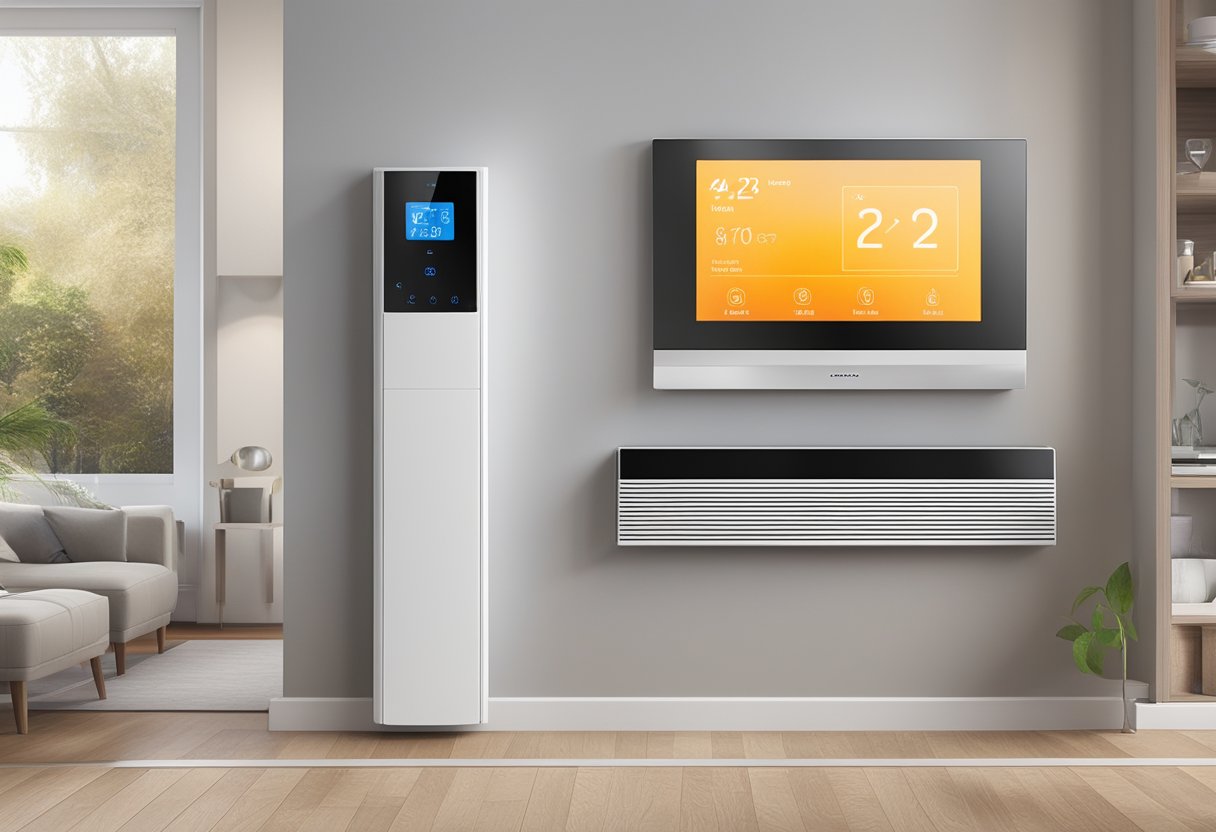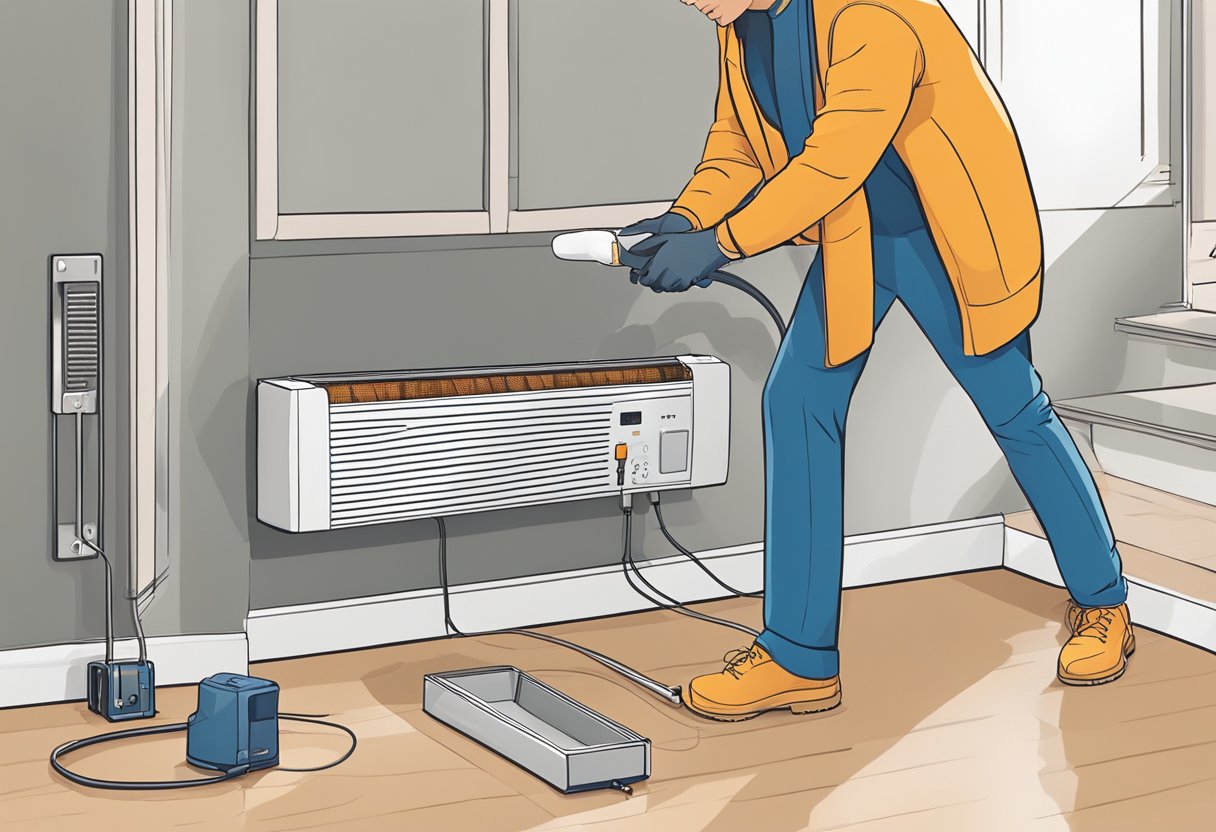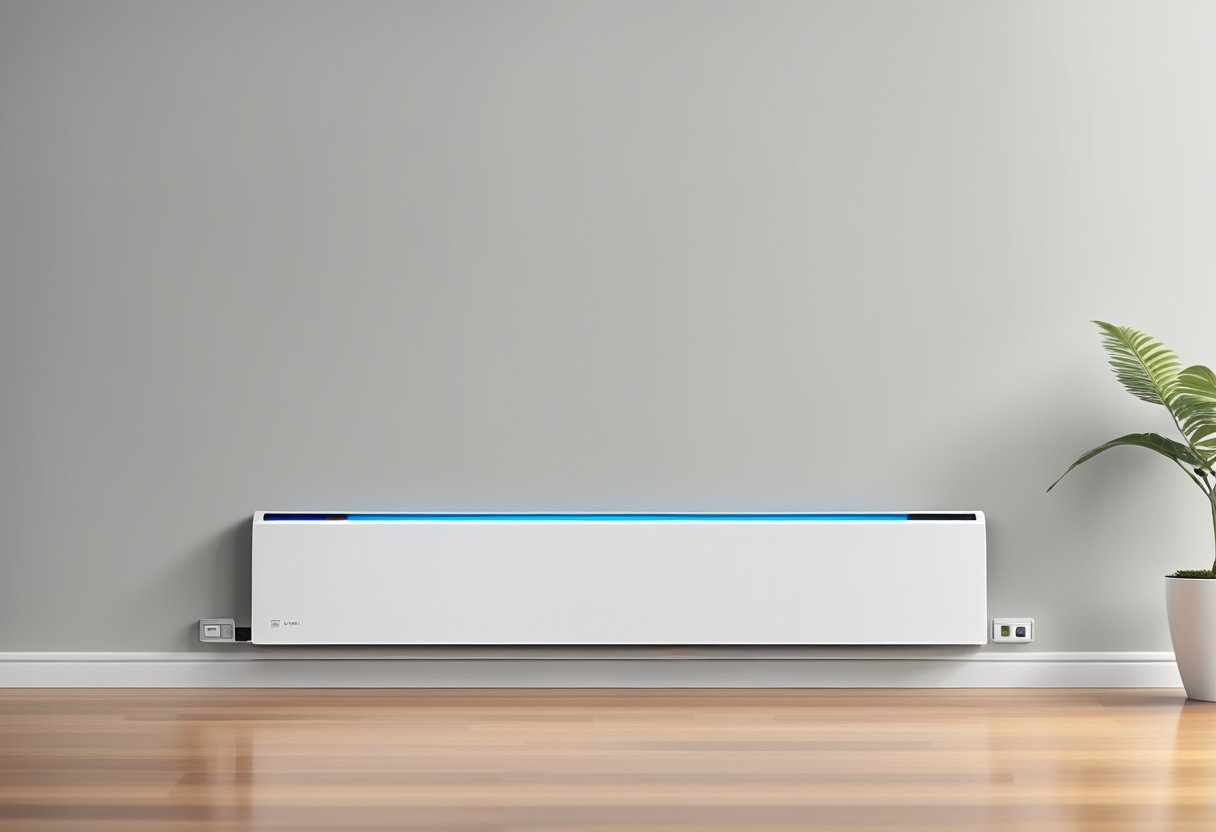
Understanding Electric Baseboard Heaters is important to appreciate the benefits of electric baseboard heaters.
These heaters work by using electricity to heat up a series of metal fins, which in turn heat the air in the room.
They are typically installed along the baseboard of a room and can be controlled by a thermostat.
While traditional baseboard heaters can be difficult to control and can result in high energy bills, electric baseboard heaters offer a more efficient and convenient solution.
They also offer energy savings and cost efficiency, making them an attractive option for those looking to reduce their energy bills.
Integrating Baseboard Heaters with Smart Home Systems is another benefit of electric baseboard heaters.
By connecting the heaters to a smart home system, homeowners can control the temperature in their home remotely, set schedules, and even receive alerts if there is a problem with the heater.
With the ability to integrate with popular smart home systems such as Alexa, Google Home, and Apple HomeKit, smart electric baseboard heaters offer a more convenient and efficient way to heat your home.
Key Takeaways
- Electric baseboard heaters offer energy savings and cost efficiency compared to traditional baseboard heaters.
- By integrating with smart home systems, homeowners can control the temperature in their home remotely and receive alerts if there is a problem with the heater.
- Understanding electric baseboard heaters is important to appreciate the benefits of smart electric baseboard heaters.
Understanding Electric Baseboard Heaters

Electric baseboard heaters are a common type of heating system that is used in many homes.
They are simple, easy to install, and can be used in almost any room in the house.
They work by using electricity to heat up a series of metal fins that are located inside the heater.
As the fins heat up, they radiate heat into the room, providing warmth and comfort.
Types of Baseboard Heaters
There are two main types of baseboard heaters: electric and hydronic.
Electric baseboard heaters are the most common type and work by using electricity to heat up the metal fins.
Hydronic baseboard heaters, on the other hand, use a liquid, such as water, to heat up the fins.
Hydronic baseboard heaters are more efficient than electric baseboard heaters, but they are also more expensive to install.
Electricity and Heating Efficiency
Electric baseboard heaters are typically rated for either 120 or 240 volts.
The higher the voltage rating, the more heat the heater can produce. However, higher voltage heaters also consume more electricity, which can lead to higher energy bills.
It is important to choose a heater that is appropriately sized for the room in which it will be used.
One of the main advantages of electric baseboard heaters is that they are very efficient.
They are able to heat a room quickly and can be easily controlled using a thermostat. However, they can also be expensive to operate, especially if they are used frequently.
It is important to consider the energy consumption of the heater when choosing a heating system for your home.
Smart Thermostats for Baseboard Heaters
Smart thermostats are becoming increasingly popular for baseboard heaters.
They offer a range of benefits over traditional thermostats, including energy savings, convenience, and enhanced control.
In this section, we will explore the benefits of smart thermostats and how to choose the right one for your baseboard heater.
Benefits of Smart Thermostats
Smart thermostats offer several benefits over traditional thermostats. Here are some of the most significant benefits:
-
Energy Savings: Smart thermostats can help you save energy and reduce your electricity bill.
They can learn your heating preferences and adjust the temperature accordingly, which can lead to significant energy savings over time.
-
Convenience: Smart thermostats offer convenient features such as remote control and voice commands.
You can control your thermostat from your smartphone, tablet, or computer, making it easy to adjust the temperature from anywhere.
-
Enhanced Control: Smart thermostats offer enhanced control over your heating system.
You can set schedules, create heating zones, and receive alerts if the temperature drops below a certain level.
Choosing the Right Smart Thermostat
When choosing a smart thermostat for your baseboard heater, there are several factors to consider. Here are some of the most important factors to keep in mind:
-
Compatibility: Make sure the smart thermostat you choose is compatible with your baseboard heater.
Some smart thermostats are designed for line voltage systems, while others are designed for low voltage systems.
-
Features: Consider the features you need in a smart thermostat.
Do you want a programmable thermostat or a non-programmable thermostat? Do you need a thermostat with remote control or voice commands?
-
Brand: Consider the brand of the smart thermostat.
Some of the most popular brands include Mysa, Nest, Ecobee, Emerson Sensi, Honeywell, Stelpro, and Sinope.
Each brand has its own strengths and weaknesses, so do your research to find the best one for your needs.
Energy Savings and Cost Efficiency

Smart electric baseboard heaters are an excellent way to reduce electricity bills and save money on energy bills.
They are designed to optimize energy usage and reduce heating bills without sacrificing comfort. Here are some ways in which smart electric baseboard heaters are energy-efficient and cost-effective.
Reducing Electricity Bills
Smart electric baseboard heaters use advanced technology to reduce electricity bills.
They come with built-in sensors that can detect when a room is empty, and automatically turn off the heater to save energy.
They can also be programmed to turn on and off at specific times of the day, reducing energy usage during peak hours when electricity rates are higher.
This feature can save homeowners up to 10% on their heating bills.
Another way smart electric baseboard heaters reduce electricity bills is by using zone heating.
This means that each room can be heated independently, so homeowners don’t have to heat the entire house when only one room is in use.
This feature can save up to 30% on heating bills.
Optimizing Energy Usage
Smart electric baseboard heaters optimize energy usage by using advanced algorithms to learn a homeowner’s heating preferences.
They can adjust the temperature based on the time of day, outside temperature, and other factors to ensure optimal comfort and energy efficiency.
This feature can save homeowners up to 15% on their heating bills.
Smart electric baseboard heaters are also eligible for rebates from energy companies.
These rebates can help offset the cost of installation and make them even more cost-effective.
Integrating Baseboard Heaters with Smart Home Systems

Smart home systems offer convenience, energy efficiency, and comfort to homeowners.
With the integration of smart electric baseboard heaters, homeowners can enjoy these benefits in their heating systems. Here is what you need to know about integrating baseboard heaters with smart home systems.
Smart Home Compatibility
Before purchasing a smart thermostat for your baseboard heater, you need to ensure it is compatible with your smart home system.
The most popular smart home systems include Amazon Alexa, Google Home, Apple HomeKit, and Samsung SmartThings.
Some smart thermostats work with all these systems, while others are limited to specific ones. Therefore, it is essential to check the compatibility before making a purchase.
Voice Control and Automation
One of the significant benefits of integrating smart electric baseboard heaters with smart home systems is the ability to control them using voice commands.
Most smart thermostats for baseboard heaters are compatible with voice control systems such as Alexa, Siri, and Google Assistant.
With voice commands, homeowners can adjust the temperature, turn the heater on or off, and set schedules without having to use a remote or smartphone.
Moreover, smart electric baseboard heaters can be automated to turn on or off based on the homeowner’s preferences.
With automation, homeowners can save energy and money by ensuring their heaters only run when they need to.
Installation and Maintenance

Professional Installation vs. DIY
When it comes to installing smart electric baseboard heaters, homeowners have the option to do it themselves or hire a professional.
DIY installation can save money, but it requires a good understanding of electrical wiring and the heating system.
It is important to note that improper installation can result in damage to the heater, boiler, or even create a fire hazard.
On the other hand, professional installation ensures that the system is installed correctly and safely.
HVAC professionals have the knowledge and expertise to install and configure the system, ensuring optimal performance and longevity.
They can also provide advice on the best heating system and thermostat options for the specific needs of the home.
Routine Maintenance Tips
Maintaining smart electric baseboard heaters is essential to ensure optimal performance and longevity. Here are some routine maintenance tips:
- Regularly clean the heater and thermostat to remove dust and debris that can accumulate over time.
- This can help prevent the system from overheating and improve indoor air quality.
- Check the wiring and connections periodically to ensure they are secure and free of damage.
- Loose or damaged wiring can cause the system to malfunction or create a fire hazard.
- Inspect the heater fins for damage or bending, which can affect the airflow and heating efficiency.
- Bent fins can be straightened with a fin comb, which is available at most hardware stores.
- Test the thermostat periodically to ensure it is functioning correctly.
- This can be done by turning the temperature up and down and checking if the heater responds accordingly.
- Consider scheduling an annual maintenance checkup with an HVAC professional.
- This is to ensure the system is running efficiently and identify any potential issues before they become major problems.
Frequently Asked Questions

What are the top-rated smart thermostats for electric baseboard heaters?
The top-rated smart thermostats for electric baseboard heaters include Mysa, Stelpro, and Sinopé.
These thermostats are designed to work with high-voltage systems and can be controlled remotely through a smartphone app.
They also offer features such as scheduling, energy usage tracking, and voice control through virtual assistants like Amazon Alexa and Google Assistant.
How do you install a smart thermostat for an electric baseboard heater?
Installing a smart thermostat for an electric baseboard heater involves turning off the power supply, removing the old thermostat, and connecting the wires to the new thermostat’s terminals.
It is important to follow the manufacturer’s instructions carefully and to ensure that the thermostat is compatible with the existing wiring and voltage of the system.
If in doubt, it is recommended to hire a licensed electrician to perform the installation.
Can existing electric baseboard heaters be upgraded to smart ones?
Yes, existing electric baseboard heaters can be upgraded to smart ones by installing a compatible smart thermostat.
This allows users to control the temperature and settings of the heater remotely, as well as to track energy usage and set schedules to optimize efficiency.
It is important to ensure that the smart thermostat is compatible with the existing wiring and voltage of the system before making the upgrade.
What are the energy efficiency benefits of using a smart electric baseboard heater?
Using a smart electric baseboard heater can lead to significant energy efficiency benefits, including reduced energy consumption and lower utility bills.
Smart thermostats allow users to set schedules and temperature preferences to optimize heating efficiency, and some models offer features such as occupancy sensing and geofencing to automatically adjust the temperature based on whether or not someone is in the room.
Additionally, some smart electric baseboard heaters are designed with energy-saving features such as zonal heating and adaptive start.
How do smart thermostats for baseboard heaters improve heating control?
Smart thermostats for baseboard heaters improve heating control by allowing users to remotely adjust temperature settings, set schedules, and track energy usage.
They also offer features such as occupancy sensing and geofencing to automatically adjust the temperature based on whether or not someone is in the room, and some models offer compatibility with virtual assistants like Amazon Alexa and Google Assistant for voice control.
By providing more precise and customizable heating control, smart thermostats can lead to increased comfort and energy efficiency.
What should be considered when choosing a smart electric baseboard heater with an integrated thermostat?
When choosing a smart electric baseboard heater with an integrated thermostat, it is important to consider factors such as compatibility with existing wiring and voltage, heating capacity, and energy efficiency.
Additional features such as zonal heating and occupancy sensing should also be taken into account.
It is also important to ensure that the heater is the appropriate size and wattage for the room in which it will be installed, and to choose a reputable brand with good customer reviews and technical support.



